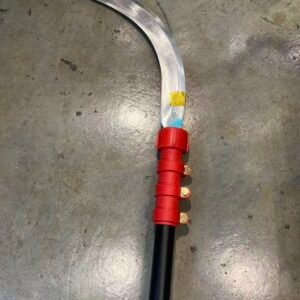Machete Description – Complete Guide for Buyers and Distributors
When U are sourcing or selling cutting tools for agriculture, forestry, or outdoor work, a clear machete description is crucial for buyers to understand product quality, durability, and performance. Whether U are a distributor in Africa, South America, or Southeast Asia, providing detailed specifications helps build trust, reduce returns, and increase sales.
This comprehensive guide covers blade types, handle materials, design features, maintenance, and buying considerations for different markets.
1. What is a Machete?
A machete is a broad, heavy knife used for cutting vegetation, harvesting crops, and outdoor survival tasks. It typically ranges from 12 to 24 inches in length, depending on its intended use. A proper machete description should include blade type, handle material, weight, length, and manufacturing process.
Machetes are commonly used in:
-
Agriculture (sugarcane, sugar beets, corn stalks)
-
Forestry (brush clearing, trail cutting)
-
Survival and camping
-
Landscaping and garden work
2. Blade Types
The blade is the heart of any machete. Modern machetes are made from high-carbon steel or stainless steel, combining hardness, flexibility, and durability. Here are the main types:
2.1 High-Carbon Steel Machetes
-
Characteristics: Hard, sharp, holds an edge longer.
-
Advantages: Excellent for heavy-duty cutting and chopping.
-
Maintenance: Requires oiling to prevent rust.
2.2 Stainless Steel Machetes
-
Characteristics: Resistant to corrosion, easier to maintain.
-
Advantages: Suitable for humid or wet climates.
-
Maintenance: Minimal; wiping clean after use is sufficient.
2.3 Specialty Blades
-
Serrated Machetes: Designed for sawing branches or tough vegetation.
-
Tactical Machetes: Designed for survival, camping, or self-defense.
-
Latin-Style / Bolo / Parang: Regional designs optimized for local crops.
3. Handle Materials
The handle affects grip, comfort, and safety. A proper machete description should highlight handle material. Common options include:
3.1 Wooden Handles
-
Comfortable, natural feel, and traditional style.
-
Can be shaped ergonomically for extended use.
3.2 Plastic or Polymer Handles
-
Lightweight, moisture-resistant, easy to clean.
-
Often used in mass-production machetes for cost efficiency.
3.3 Rubber or Composite Handles
-
Provides extra grip in wet conditions.
-
Reduces hand fatigue during prolonged use.
4. Blade Design and Weight
4.1 Blade Length
-
Short blades (12–14 inches) are easier to control and ideal for light work.
-
Medium blades (15–18 inches) are versatile for general agriculture.
-
Long blades (18–24 inches) are best for heavy-duty cutting.
4.2 Blade Thickness
-
Thin blades (2–3 mm) are easier for slicing and quick cutting.
-
Thick blades (4–6 mm) are stronger and better for chopping dense vegetation.
4.3 Weight Distribution
-
Forward-weighted blades increase chopping efficiency.
-
Balanced blades improve control and reduce user fatigue.
5. Uses of a Machete
Machetes are versatile tools. Clear machete description guides should specify typical applications:
-
Agricultural Work: Cutting sugarcane, clearing weeds, harvesting crops.
-
Forestry & Landscaping: Clearing bushes, trimming branches, trail maintenance.
-
Outdoor Survival: Shelter building, firewood chopping, camping tasks.
-
Specialty Applications: Cane knives for sugarcane, billhooks for forestry, tactical use.
6. Maintenance and Care
A detailed machete description should include care instructions to maximize blade life:
-
Cleaning: Wipe blade after each use.
-
Oiling: Apply a thin layer of oil to carbon steel blades to prevent rust.
-
Sharpening: Use a whetstone or sharpening file regularly to maintain cutting edge.
-
Storage: Store in a dry place with sheath protection.
7. Safety Tips
When distributing or selling machetes, safety instructions are crucial:
-
Always wear gloves when using or sharpening.
-
Keep the blade away from children.
-
Use appropriate techniques to prevent injuries during chopping.
-
Ensure a secure grip on the handle, especially in wet conditions.
8. How to Write a Machete Description for B2B Buyers
A strong machete description should include:
-
Blade Material: High-carbon steel, stainless steel, or specialty alloy.
-
Blade Length and Thickness: Specify in inches or mm.
-
Handle Material and Type: Wood, polymer, rubber, ergonomic design.
-
Weight: Total weight in grams or pounds.
-
Use Case: Agriculture, forestry, survival, or general outdoor work.
-
Manufacturing Process: Forged, heat-treated, polished, tempered.
-
Packaging: OEM/ODM options, single units, or bulk cartons.
-
Certifications: ISO, CE, or local standards, if applicable.
Including all these details ensures buyers understand exactly what they are purchasing and helps distributors explain product features to their clients.
9. Market Insights
B2B buyers often look for:
-
High-quality blades: Hold sharpness, resist bending, durable.
-
Affordable pricing: Especially for bulk orders in African or South American markets.
-
Consistent production: Reliable supply is critical to avoid delays during peak seasons.
-
OEM/ODM flexibility: Ability to customize branding or packaging.
For example, distributors in Ghana often buy machetes with wooden handles and high-carbon blades, while Southeast Asian clients prefer stainless steel for wet climates.
10. Conclusion
A well-written machete description is essential for effective marketing, both online and offline. By including detailed specifications, uses, maintenance instructions, and safety tips, you provide buyers with confidence and increase the likelihood of repeat orders.
-
Highlight blade material and quality.
-
Specify handle type and ergonomics.
-
Include intended use and care instructions.
-
Offer OEM/ODM options for bulk buyers.
Whether U are a manufacturer, exporter, or distributor, a clear machete description ensures your products are understood, trusted, and preferred by global buyers.
View products




